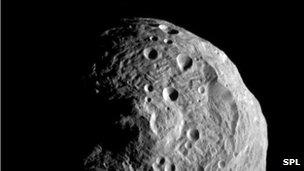Asteroid makes near-miss fly-by
- Published

The asteroid is minuscule relative to the recently photographed asteroid Vesta
An asteroid hurtled past the Earth on Friday in something of a cosmic near-miss, making its closest approach at about 1600 GMT.
The asteroid, estimated to be about 11m (36ft) in diameter, was first detected on Wednesday.
At its closest, the space rock - named 2012 BX34 - passed within about 60,000km of Earth - less than a fifth of the distance to the Moon.
Astronomers stressed that there had been no cause for concern.
"It's one of the closest approaches recorded," said Gareth Williams, associate director of the US-based Minor Planet Center.
"It makes it in to the top 20 closest approaches, but it's sufficiently far away... that there's absolutely no chance of it hitting us," he told the BBC.
The asteroid's path made it the closest space-rock to pass by the Earth since object 2011 MD in June 2011.
Gareth Williams, Minor Planet Centre: "There's absolutely no chance of it hitting us"
Earlier estimates had put the asteroid's closest distance at as little as 20,000km, but studies by observatories overnight into Friday showed it would pass at a more comfortable distance.
Although the asteroid was not visible to the naked eye, Dr Williams said that keen backyard astronomers had been busy getting a look.
"We've had three sets of observations in the last few hours from amateur observers in the UK," he said.
- Published20 January 2012
- Published9 November 2011